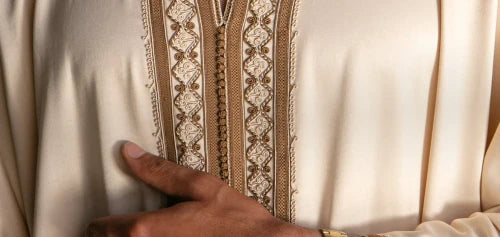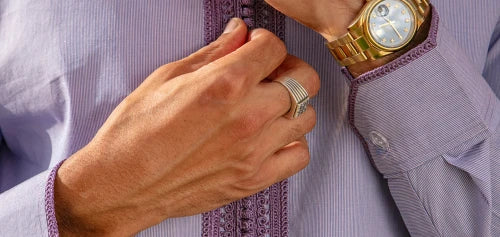Morocco is celebrated worldwide for its rich culture, exquisite cuisine, and unique hospitality, but its traditional attire also plays a significant role in its identity.
In its earliest form, the Jabador was worn mainly by men, typically in neutral or earth-tone colours. Its lightweight fabric and relaxed fit were ideal for the North African climate, and the garment was often worn under the djellaba. Garments like the jellaba, caftan and babouches are not only fashion statements but also represent the country’s craftsmanship. Among these, the Jabador has gained special attention in recent years as the ultimate festive wear.
While Moroccan fashion continues to evolve, the quality and artistry behind these creations remain central, with the Jabador now becoming increasingly popular at formal events and celebrations worldwide.
Not long ago, we shared a post on How to choose a Traditional Moroccan Jabador where we explained the different Jabador trends, where to buy one and how to take care of and store your new Moroccan Jabador. However, today we will cover its origins, history and how it evolved through time.
Origins and Traditional Use
According to some Moroccan archives, it is believed that the Jabador style clothing emerged from Ottoman, Persian, and Andalusian influences.
Originally designed as a men’s garment, the Jabador was an everyday casual dress. The outfit's simplicity and functionality made it popular among men, both in Morocco’s urban and rural areas. Its defining features include a loose-fitting tunic, paired with trousers called ' sarouel' or 'sarwal', made for both comfort and modesty. Traditionally worn under the djellaba, a sleeveless jacket was later added, completing the look.
The trousers are traditionally three quarter length, loose fitting at the crutch, then get more fitted as they go down the leg. The style of these unique shaped pants made it modest, light and comfortable for the man's 'awrah' and really easy to make wudhu in, as it stopped just before reaching the ankles.
In Islam, the man isn't permitted to wear any form of clothing that drags over his ankles. It was common in that era for rich leaders and elites to wear long cloaks and gowns that dragged on the floor behind them to indicate wealth, status and arrogance. Islam on the other hand, teaches us to be humble and not to waste.
Jabir ibn Sulaym said: The Messenger of Allah said to me: “Beware of wearing one's lower garment below the ankles, because this is a kind of showing-off, and Allah does not love showing-off.” source: Islamqa.info
The Jabador, like many traditional Moroccan garments, reflects the country's diverse Muslim and cultural influences, from Ottoman, Persian, Arab, and Berber to Andalusian.
In the 16th century, the Jabador became a symbol of elite status, worn by notables and artisans and by the 19th century, it was recognized in European literature as common attire in cities like Tangier, without displacing other traditional garments.
Evolution Over Time
Similar to other countries, the clothing in Morocco changed differently depending on the region, climate, and tribal traditions, and the Jabador is no exception. Regional differences shape its design, with urban areas showing more notable modifications.
In the 20th century, designers infused the Jabador with modern touches, such as transforming the sarwal into embroidered trousers and shortening the tunic to the waste. The transparent vest reintroduced a fabric style from the 16th century. Contemporary designers continue to reinterpret the Jabador while maintaining its traditional elegance, making it a garment for grand occasions today.

Image Source: wikimedia.org
The Jabador for Women
While the Jabador was originally designed for men, the garment has evolved over the centuries. In modern times, the Jabador has become increasingly popular among women, with designers adapting the traditional style to suit contemporary fashion trends. Women's Jabadors often feature more vibrant colours, intricate embroidery, and finer fabrics like silk or chiffon, making them suitable for a variety of occasions, from casual wear to formal events.
This evolution mirrors the changing role of women in Moroccan society, where traditional clothing is now seen as a blend of cultural heritage and modern fashion. What was once a simple men's garment has now expanded into a versatile piece for both genders, reflecting Morocco’s ability to embrace tradition while adapting to contemporary trends.

Famous Designers and the Jabador
The Jabador has caught the attention of fashion designers globally, both within Morocco and beyond. Moroccan designer Albert Oiknine is well-known for incorporating traditional Moroccan garments, including the Jabador, into his haute couture collections. His modern take on the Jabador, blending traditional elements with luxurious fabrics and bold colours, has been showcased at international fashion events.
Additionally, designers like Fadila El Gadi, celebrated for her intricate embroidery work, have brought attention to traditional Moroccan clothing. By reinventing garments such as the Jabador for both men and women, these designers have introduced Moroccan fashion to a global audience, celebrating the beauty and craftsmanship of the country’s rich sartorial heritage.
The Jabador Today
In contemporary Moroccan society, the Jabador remains a beloved garment, worn by both men and women during various events. For men, it is still an essential part of religious and cultural ceremonies, often worn during Friday prayers, weddings, or religious festivals. Women, on the other hand, wear modern versions of the Jabador that may feature detailed embroidery, slimmer cuts, and lighter fabrics, making the outfit both elegant and fashionable.
The Jabador’s versatility also means that it is commonly paired with other traditional garments, like the djellaba or kaftan, depending on the occasion. Whether for formal gatherings or casual outings, the Jabador continues to be a symbol of Moroccan heritage, while embracing the modern-day fashion needs of both men, women and even children.

Image Source: nz.pinterest.com
Where & When is The Jabador Traditionally Worn?
Moroccan traditional dress remains an essential part of women's wardrobes, regardless of class or lifestyle. While modern influences have introduced variations, the core of Moroccan clothing stays true to its roots. At events, religious celebrations, or local festivities, Moroccan men and women proudly embrace their cultural attire, reflecting a deep respect for tradition. Though European-style clothing is becoming more common in cities, traditional garments continue to be widely worn and celebrated, showcasing the regional diversity and cultural pride that transcend fleeting fashion trends.
Weddings
Weddings in Morocco are steeped in tradition, and the Jabador is the quintessential attire for grooms. Other participants, such as the bearers in the Amariya ritual, also wear the Jabador paired with a selham, enhancing the ceremonial grandeur. This tradition remains alive even among younger generations, keeping cultural heritage vibrant.
Eid Celebrations
For Eid, men wear their finest attire, following prophetic tradition. The Jabador is a perfect choice, combining elegance with adherence to Islamic customs.
Circumcision
Even young boys have their own Jabadors, making special events like circumcision meaningful by honoring tradition through dress.
Conclusion
The Jabador, once a simple men’s garment, has transformed into a versatile and timeless piece that transcends gender and occasion. With its deep cultural roots and ongoing evolution, the Jabador remains a proud representation of Moroccan fashion, carrying the traditions of the past into the future. The work of famous Moroccan designers continues to keep this garment relevant, blending history and innovation to ensure that the Jabador remains an iconic part of Morocco's cultural and fashion identity.









